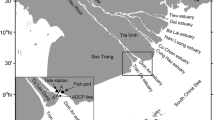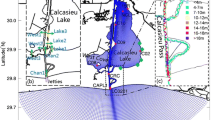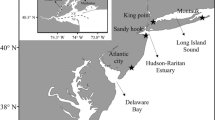Abstract
Classical estuary circulation theory states that in the longitudinal direction of an estuary there exists a single circulation with landward, near-bottom, and seaward, near-surface flows; however, the situation becomes complicated with the presence of a river mouth bar. Here we conducted tidal-cycle observations in the South Passage of the Yangtze Estuary during both the wet and dry seasons of 2018 (July and December, respectively). The simultaneous current velocity, temperature, and salinity profile data were obtained from anchored boats and base tripods at three stations along the channel in the mouth bar area. The results reveal two distinct longitudinal residual circulation patterns: a classic circulation which is formed on the seaward slope of the mouth bar during the wet season, and a double circulation system which is composed of two circulation cells over the landward and seaward slopes of the mouth bar during the dry season. The Simpson number (Si), mixing parameter (M), and salinity data were used to quantify the mixing intensity, which shows that horizontal baroclinic pressure gradient is the dominant factor in the formation of the longitudinal residual circulation. Furthermore, the double circulation pattern during the dry season is related to the mouth bar bathymetry, which affects saltwater intrusion. The double circulations can significantly influence the spatial and temporal evolution of the stagnation point in the estuarine channel, which in turn modifies the distribution patterns of suspended sediment concentration in the maximum turbidity zone. Evidently, the changes in the mouth bar sandbar bathymetry in response to human activities and river basin hydrographic conditions indirectly affect the occurrence and scale of the double circulations.
Similar content being viewed by others
References
Becherer J, Stacey M T, Umlauf L, Burchard H. 2015. Lateral circulation generates flood tide stratification and estuarine exchange flow in a curved tidal inlet. J Phys Oceanogr, 45: 638–656
Buchan A. 1897. Specific gravities and oceanic circulation. Trans R Soc Edinb, 38: 317–342
Burchard H, Hetland R D. 2010. Quantifying the contributions of tidal straining and gravitational circulation to residual circulation in periodically stratified tidal estuaries. J Phys Oceanogr, 40: 1243–1262
Cao D F, Shen Y M, Su M R, Yu C X. 2019. Numerical simulation of hydrodynamic environment effects of the reclamation project of Nanhui tidal flat in Yangtze Estuary. J Hydrodyn, 31: 603–613
Cao G P, Song J B, Fan W. 2013. Evolution mechanism of summer upwelling in waters adjacent to the Yangtze River Estuary in 2007 (in Chinese). Mar Sci, 37: 102–112
Changjiang water resources commission of the ministry of water resources. 2020. Yangtze River Sediment Bulletin 2019 (in Chinese). Wuhan: Yangtze River Press. 51
Chant R J. 2010. Estuarine secondary circulation. In: Valle-Levinson A, ed. Contemporary Issues in Estuarine Physics. New York: Cambridge University Press. 100–124
Chant R J, Wilson R E. 2000. Internal hydraulics and mixing in a highly stratified estuary. J Geophys Res, 105: 14215–14222
Chen J Y, Cheng H Q, Dai Z J. 2008. The role and response of the third driving force in the estuarine process: A case study of the Yangtze Estuary (in Chinese). Prog Nat Sci, 18: 994–1000
Cheng P, Valle-Levinson A, de Swart H E. 2011. A numerical study of residual circulation induced by asymmetric tidal mixing in tidally dominated estuaries. J Geophys Res, 116: C01017
Dai Z J, Liu J T, Fu G, Xie H L. 2013. A thirteen-year record of bathymetric changes in the North Passage, Changjiang (Yangtze) estuary. Geomorphology, 187: 101–107
Ding R, Chen X E, Qu N D. 2016. Three-dimensional high-resolution numerical study of tide and circulation in the Pearl River Estuary and its adjacent waters II: Estuarine mass transport and water exchange (in Chinese with English abstract). J Ocean Univ China, 46: 1–10
Endoh T, Yoshikawa Y, Matsuno T, Wakata Y, Lee K J, Umlauf L. 2016. Observational evidence for tidal straining over a sloping continental shelf. Cont Shelf Res, 117: 12–19
Farmer D M, Armi L. 1986. Maximal two-layer exchange over a sill and through the combination of a sill and contraction with barotropic flow. J Fluid Mech, 164: 53–76
Fischer H B. 1972. Mass transport mechanisms in partially stratified estuaries. J Fluid Mech, 53: 671–687
Fisher N R, Simpson J H, Howarth M J. 2002. Turbulent dissipation in the Rhine ROFI forced by tidal flow and wind stress. J Sea Res, 48: 249–258
Gao Q Q, Jiang X J, Zhu J R. 2013. Brief analysis of the impact of the runoff, salinity front and topography variation on the estuary circulation (in Chinese). Shanghai Water, 29: 26–28, 25
Geyer W R, MacCready P. 2014. The estuarine circulation. Annu Rev Fluid Mech, 46: 175–197
Gu J, Zheng Y H, Wang X L, Ma D Q. 2016. Numerical analysis of movement of stagnant points in the Yangtze Estuary during the wet and dry seasons (in Chinese). Mar Sci, 40: 114–122
Guo X B, Li J F, Li Z H, Wang Y B. 2012. Characteristics of water and sediment transport in the South Passage of the Yangtze Estuary in recent years (in Chinese). Yangtze River, 43: 1–5
Hansen D V, Rattray M. 1965. Gravitational circulation in straits and estuaries. J Mar Res, 23: 104–122
He S L, Sun J M. 1996. Characteristics of suspended sediment transport in the maximum turbidity zone of the Yangtze Estuary (in Chinese). Oceanol Limnol Sin, 27: 60–66
He Y, Cheng H, Chen J. 2013. Morphological evolution of mouth bars on the Yangtze estuarine waterways in the last 100 years. J Geogr Sci, 23: 219–230
Jay D A, Musiak J D. 1994. Particle trapping in estuarine tidal flows. J Geophys Res, 99: 20445–20461
Jay D A, Smith J D. 1990a. Residual circulation in shallow estuaries: 1. Highly stratified, narrow estuaries. J Geophys Res, 95: 711–731
Jay D A, Smith J D. 1990b. Residual circulation in shallow estuaries: 2. Weakly stratified and partially mixed, narrow estuaries. J Geophys Res, 95: 733–748
Lacy J R, Stacey M T, Burau J R, Monismith S G. 2003. Interaction of lateral baroclinic forcing and turbulence in an estuary. J Geophys Res, 108: 3089
Lerczak J A, Geyer R W. 2004. Modeling the lateral circulation in straight, stratified estuaries. J Phys Oceanogr, 34: 1410–1428
Li J F, Shi W R, Shen H T. 1994. Sediment characteristics and transport laws in the maximum turbidity zone of the Yangtze Estuary (in Chinese). Geogr Res, 13: 51–59
Li L J, Zhu J R. 2015. Impacts of the reclamation project of Nanhui tidal flat on the currents and saltwater intrusion in the Changjiang estuary (in Chinese). J East China Normal Univ-Nat Sci, (4): 77–86
Lorke A, Umlauf L, Mohrholz V. 2008. Stratification and mixing on sloping boundaries. Geophys Res Lett, 35: L14610
Lorrai C, Umlauf L, Becherer J K, Lorke A, Wüest A. 2011. Boundary mixing in lakes: 2. Combined effects of shear- and convectively induced turbulence on basin-scale mixing. J Geophys Res, 116: C10018
Lü X G, Qiao F L, Xia C S, Zhou J R, Yuan Y L. 2006. Upwelling off Yangtze River estuary in summer. J Geophys Res, 111: C11S08
Mao Z C. 1995. Study on saline intrusion front in the Changjiang Estuary (in Chinese). Oceanol Limnol Sin, 26: 643–649
Nepf H M, Geyer W R. 1996. Intratidal variations in stratification and mixing in the Hudson estuary. J Geophys Res, 101: 12079–12086
Officer C B. 1976. Physical Oceanography of Estuaries (and Associated Coastal Waters). New York: John Wiley and Sons Inc. 465
Peng Z Y, Jiang X Z, Hou L J, He Q. 2020. Vertical profiles of suspended sediment and salinity in the maximum turbidity zone of the Yangtze Estuary during the dry season of 1982 and 2012 (in Chinese). Mar Geol Front, 36: 7–18
Pritchard D W. 1952. Estuarine hydrography. Adv Geophys, 1: 243–280
Rippeth T P, Fisher N R, Simpson J H. 2001. The cycle of turbulent dissipation in the presence of tidal straining. J Phys Oceanogr, 31: 2458–2471
Ross L, Sottolichio A, Maury T, Lesourd S, Gardel A. 2019. Intratidal and subtidal circulation in a tropical estuary during wet season: The Maroni, French Guiana. JMSE, 7: 433
Schoellhamer D H. 2000. Influence of salinity, bottom topography, and tides on locations of estuarine turbidity maxima in northern San Francisco Bay. Proc Mar Sci, 3: 343–357
Schulz K, Endoh T, Umlauf L. 2017. Slope-induced tidal straining: Analysis of rotational effects. J Geophys Res-Oceans, 122: 2069–2089
Schwing F B, Kjerfve B, Sneed J E. 1983. Nearshore coastal currents on the South Carolina continental shelf. J Geophys Res, 88: 4719–4729
Scott C F. 1994. A numerical study of the interaction of tidal oscillations and non-linearities in an estuary. Estuar Coast Shelf Sci, 39: 477–496
Shen H T, Zhu H F, Mao Z C. 1986. Circulation of the Changjiang river estuary and its effect on the transport of suspended sediment (in Chinese). Oceanol Limnol Sin, 17: 26–35
Shen J S, Zhu Z M, Zhang X Q. 1983. Genesis and evolution of the sandbar in the South Passage of the Changjiang Estuary (in Chinese). Oceanol Limnol Sin, 14: 582–590
Simpson J H, Brown J, Matthews J, Allen G. 1990. Tidal straining, density currents, and stirring in the control of estuarine stratification. Estuaries, 13: 125–132
Simpson J H, Gong W K, Ong J E. 1997. The determination of the net fluxes from a mangrove estuary system. Estuaries, 20: 103–109
Simpson J H, Sharpies J. 1992. Dynamically-active models in the prediction of estuarine stratification. In: Prandle D, eds. Dynamics and Exchanges in Estuaries and the Coastal Zone. Durham: American Geophysical Union (AGU). 101–113
Smith R. 1976. Longitudinal dispersion of a buoyant contaminant in a shallow channel. J Fluid Mech, 78: 677–688
Stacey M T, Monismith S G, Burau J R. 1999. Observations of turbulence in a partially stratified estuary. J Phys Oceanogr, 29: 1950–1970
Umlauf L, Burchard H. 2011. Diapycnal transport and mixing efficiency in stratified boundary layers near sloping topography. J Phys Oceanogr, 41: 329–345
Wang J X, Wang T, Xing F, Wu H, Jia J J, Yang Z S, Wang Y P. 2020. Internal waves triggered by river mouth shoals in the Yangtze River Estuary. Ocean Eng, 214: 107828
Xie H L, Dai Z J, Zuo S H, Han Z Y. 2015. Morphodynamic processes of the South Passage of the Yangtze estuary (1959-2013) (in Chinese). Ocean Eng, 33: 51–59
Xing J, Davies A M. 2006. Influence of stratification and topography upon internal wave spectra in the region of sills. Geophys Res Lett, 33: L23606
Xing J, Davies A M. 2011. Tidal mixing in sill regions: Influence of sill depth and aspect ratio. Ocean Dyn, 61: 1697–1717
Xu H J, Huang Z, Bai Y, Bai Y C. 2020. Effects of flow circulations on the sediment dynamics in the deep-water navigation channel of the Yangtze River Estuary. J Coast Res, 95: 723–727
Xu X J, Yang S L, Li P. 2008. Difference in response of estuarine channel and estuarine seashore to sediment discharge reduction: A case study of the south channel of the Changjiang Estuary and estuarine seashore system (in Chinese). Mar Sci Bull, 27: 100–104
Yang H F, Li B C, Zhang C Y, Qiao H J, Liu Y T, Bi J F, Zhang Z L, Zhou F N. 2020. Recent spatio-temporal variations of suspended sediment concentrations in the Yangtze Estuary. Water, 12: 818
Yang S L, Zhao Q Y, Ding P X, Xie W H. 2001. Study on the main controlling factors of seasonal scour and deposition in the sandbar channel of the Changjiang Estuary (in Chinese). Resour Environ Yangze Basin, 10: 258–265
Yun C X. 2004. Recent Evolution of the Changjiang Estuary (in Chinese). Beijing: Ocean Press. 290
Zhao B R. 1993. Upwelling phenomenon outside the Yangtze River estuary (in Chinese). Acta Oceanol Sin, 15: 108–114
Zhou C X. 2018. Characteristics and rules of saltwater intrusion in the Yangtze Estuary (in Chinese). J Yangtze River Sci Res Inst, 35: 28–33
Zhu J R. 2003. Dynamic mechanism of upwelling on the west side of the underwater valley outside the Changjiang Estuary in summer (in Chinese). Chin Sci Bull, 48: 2488–2492
Acknowledgements
We thank Hui SHENG, Ting LU, Yaqing ZHAO, Yang CHANG, Dezhi CHEN, and Tingfei LAN for their assistance with the field observations and laboratory sample processing. This work was supported by the Science Foundation for Distinguished Young Scholars of the National Natural Science Foundation of China (Grant No. 41625021) and the Innovation Program of Shanghai Municipal Education Commission (Grant No. 2019-01-00-05-E00027).
Author information
Authors and Affiliations
Corresponding author
Rights and permissions
About this article
Cite this article
Zhang, L., Yang, Z., Zhang, F. et al. Longitudinal residual circulation in the South Passage of Yangtze Estuary: Combined influences from runoff, tide and bathymetry. Sci. China Earth Sci. 64, 2129–2143 (2021). https://doi.org/10.1007/s11430-021-9813-7
Received:
Revised:
Accepted:
Published:
Issue Date:
DOI: https://doi.org/10.1007/s11430-021-9813-7




